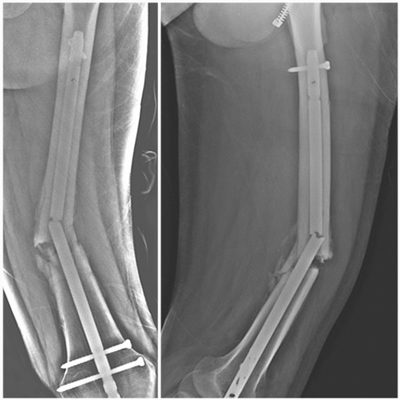Técnicas de extracción de clavos endomedulares retrógrados de fémur rotos. Presentación de tres casos
Contenido principal del artículo
Resumen
Conclusiones: Las técnicas utilizadas fueron simples, seguras, mínimamente invasivas y muy reproducibles.
Descargas
Métricas
Detalles del artículo
La aceptación del manuscrito por parte de la revista implica la no presentación simultánea a otras revistas u órganos editoriales. La RAAOT se encuentra bajo la licencia Creative Commons 4.0. Atribución-NoComercial-CompartirIgual (http://creativecommons.org/licenses/by-nc-sa/4.0/deed.es). Se puede compartir, copiar, distribuir, alterar, transformar, generar una obra derivada, ejecutar y comunicar públicamente la obra, siempre que: a) se cite la autoría y la fuente original de su publicación (revista, editorial y URL de la obra); b) no se usen para fines comerciales; c) se mantengan los mismos términos de la licencia.
En caso de que el manuscrito sea aprobado para su próxima publicación, los autores conservan los derechos de autor y cederán a la revista los derechos de la publicación, edición, reproducción, distribución, exhibición y comunicación a nivel nacional e internacional en las diferentes bases de datos, repositorios y portales.
Se deja constancia que el referido artículo es inédito y que no está en espera de impresión en alguna otra publicación nacional o extranjera.
Por la presente, acepta/n las modificaciones que sean necesarias, sugeridas en la revisión por los pares (referato), para adaptar el trabajo al estilo y modalidad de publicación de la Revista.
Citas
hundred and twenty cases. J Bone Joint Surg Am 1984;66(4):529-39. PMID: 6707031
2. Pereira S, Lugones A, Vindver GI, Bidolegui FM. Enclavado endomedular retrógrado en fracturas diafisarias de
fémur: indicaciones, técnica y resultados. Rev Asoc Argent Ortop Traumatol 2014;79(4):210-17. https://doi.org/10.15417/340
3. Sanders R, Koval KJ, DiPasquale T, Helfet DL, Frankle M. Retrograde reamed femoral nailing. J Orthop Trauma
1993;7(4):293-302. https://doi.org/10.1097/00005131-199308000-00001
4. Janzing HM, Stockman B, Van Damme G, Rommens P, Broos PL. The retrograde intramedullary nail: prospective experience in patients older than sixty-five years. J Orthop Trauma 1998;12(5):330-3.
https://doi.org/10.1097/00005131-199806000-00006
5. Benirschke SK, Melder I, Henley MB, Routt ML, Smith DG, Chapman JR, et al. Closed interlocking nailing
of femoral shaft fractures: assessment of technical complications and functional outcomes by comparison of a
prospective database with retrospective review. J Orthop Trauma 1993;7(2):118-22. PMID: 8459295
6. Tornetta P 3rd, Tiburzi D. The treatment of femoral shaft fractures using intramedullary interlocked nails with and without intramedullary reaming: a preliminary report. J Orthop Trauma 1997;11(2):89-92.
https://doi.org/10.1097/00005131-199702000-00003
7. Pape HC, Remmers D, Regel G, Tscherne H. Pulmonale Komplikationen nach intramedullärer Stabilisierung langer Röhrenknochen. Einfluss von Operationsverfahren, -Zeitpunkt und Verletzungsmuster [Pulmonary complications following intramedullary stabilization of long bones. Effect of surgical procedure, time and injury pattern]. Orthopade 1995;24(2):164-72. PMID: 7753541
8. Moed BR, Watson JT. Retrograde intramedullary nailing, without reaming, of fractures of the femoral shaft in
multiply injured patients. J Bone Joint Surg Am 1995;77(10):1520-7. https://doi.org/10.2106/00004623-199510000-00006
9. Franklin JL, Winquist RA, Benirschke SK, Hansen ST Jr. Broken intramedullary nails. J Bone Joint Surg Am
1988;70(10):1463-71. PMID: 3198670
10. Brewster NT, Ashcroft GP, Scotland TR. Extraction of broken intramedullary nails--an improvement in technique. Injury 1995;26(4):286. https://doi.org/10.1016/0020-1383(95)90020-x
11. Hak DJ, McElvany M. Removal of broken hardware. J Am Acad Orthop Surg 2008;16(2):113-20.
https://doi.org/10.5435/00124635-200802000-00009
12. Blake SM. A technique for the removal of the distal part of a broken intramedullary nail. Ann R Coll Surg Engl
2009;91(2):169-70. https://doi.org/10.1308/rcsann.2009.91.2.169
13. Magu NK, Sharma AK, Singh R. Extraction of the broken intramedullary femoral nail--an innovative technique.
Injury 2004;35(12):1322-3. https://doi.org/10.1016/S0020-1383(03)00314-0
14. Karladani AH. Removal of a broken nail using a guide wire and a screw. Acta Orthop 2006;77(6):986-8.
https://doi.org/10.1080/17453670610013330
15. Abdelgawad AA, Kanlic E. Removal of a broken cannulated intramedullary nail: review of the literature and a case report of a new technique. Case Rep Orthop 2013;2013:461703. https://doi.org/10.1155/2013/461703
16. Acharya M, Alani A, Almedghio S. The Fish Hook Technique of extracting broken intramedullary nails. Acta
Orthop Belg 2008;74(5):686-8. PMID: 19058706
17. Whalley H, Thomas G, Hull P, Porter K. Surgeon versus metalwork--tips to remove a retained intramedullary nail fragment. Injury 2009;40(7):783-9. https://doi.org/10.1016/j.injury.2008.12.009

